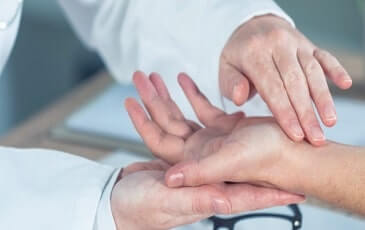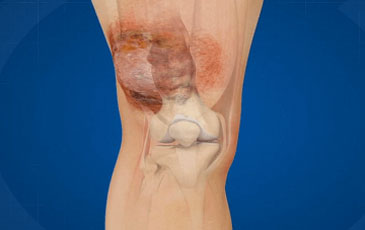Limb Salvage Surgery
Limb Salvage Surgery is performed to remove a tumor in a limb without removing the entire limb. The bone and tissue around the tumor are removed and replaced with a functional limb by using a metal implant.
Limb Salvage Surgery is performed to remove a tumor in a limb without removing the entire limb. The bone and tissue around the tumor are removed and replaced with a functional limb by using a metal implant.
Vascular injury of the limb is caused by explosions and projectiles, it affects the arteries and veins of the limbs, it happens mostly to veterans, it triggers bleeding, and ischemia. The high usage of high energy weapons is associated with vascular injury.
The mangled extremity is a limb with an injury to any of the three out of four systems - soft tissue, bone, nerves, and vessels. Mangled extremities have mostly been associated with very high amputation rates.
After a crush injury, limb salvage can be an alternative to amputation. By saving the limb, patients may get the recovery outcome they prefer, it is also cost-effective than amputation in the long run.


Amputation is a surgery that is done to remove all or part of a limb or extremity such as arm, leg, foot, hand. The reason for amputation is – poor circulation because of damage of the arteries, cancerous tumor, injury, infection.
Nerve injury happens due to damage by pressure, stretching, or cutting. Signals to and from the brain are stopped. This condition doesn’t allow the muscles to function properly and also cause numbness in the injured area.

Open fracture with bone loss may occur from extrusion of fragments at the time of injury or during the removal of damaged tissue of an open fracture when weak segments of bone are removed. Due to the problems involved in initial limb salvage and followed by reconstructing large skeletal defects many fractures with significant bone loss were treated by primary amputation.
Road traffic accidents are the major cause of serious injury and death everywhere. Orthopedic surgeons come across horribly injured people who drive after consuming alcohol or person who does not wear a helmet or seat belt.
Polytrauma and multiple traumata are the medical terms that describe the medical condition of a person who has got multiple injuries to multiple body parts and organ systems. TBI may occur along with polytrauma.
Multidisciplinary approach- There are considerable morbidity and mortality associated with ulceration of the lower limbs in patients with diabetes as well as non-diabetic patients. The experts work in multidisciplinary teams to develop a modified treatment plan for each injured person, after a thorough evaluation the team includes primary care physician and podiatrist, vascular surgeons and interventionalists, plastic surgeons. The multidisciplinary approach provides a complete treatment protocol and tries to increase the chances of successful healing.
Vascular repair- vascular damage happens due to the plaque that builds up inside the arteries. The most common vascular disease is PAD, in which the arteries in your leg are affected. The vascular repair treatments include – lifestyle changes, exercises, medicines such as blood pressure medicines, blood thinners, cholesterol medicines, and clot-dissolving drugs, for few patients a catheter is used to send medicine directly to a blood vessel. Non-surgical procedures, such as angioplasty, stenting, and vein ablation, surgery.
Nerve repair- when a nerve is cut or damaged it will repair itself. The nerve fibres (axons) may take about a month to grow again. It takes a long time and always incomplete. With surgery, nerve ends are brought together for a speedy recovery. If the nerve ends are not brought together, the axons will still grow and find the other end. This may result to lump of nerve ends (a neuroma) that gives pressure and discomfort.
Limb reconstruction is a technique to alter the shape or length of a bone. The procedure is known as osteotomy. This procedure is done to repair a damaged joint which exists from birth or due to any trauma. This surgery is done by using an external fixator which is attached to the bone by screws and wires.
Flap surgery involves shifting healthy, live tissue from one part of the body to another - often to areas that have lost skin, fat, muscle movement, or skeletal support.
Exposed bone with a fracture occurs due to a wide variety of wounds ranging from pressure and neuropathic ulcers to surgical wounds. The wound will cover spontaneously with granulation tissue followed by epithelium. If wound closure delays then osteomyelitis may develop and lead to infection or require amputation.
Post-traumatic deformity in children can occur due to a variety of traumatic injuries; mostly it happens due to malunion fracture. After some time these injuries doesn’t heal properly and cause further complications.
A blast injury is a severe type of physical trauma resulting from direct or indirect exposure to an explosion. There are 4 types of blast injuries –Primary injuries, secondary injuries, tertiary injuries, quaternary injuries.
Gunshot wounds occur when someone is shot by a bullet or other sort of projectile from a firearm. Gunshot wounds can cause serious injury such as bleeding, damage to tissues and organs, broken bones, wound infections, paralysis.
Degloving is a severe injury that occurs when the top layers of the skin and tissue are ripped from the underlying muscle, connective tissue, or bone. It affects any part of the body, mostly in the legs. These injuries are life-threatening because of heavy blood loss and tissue death.

Monday - Saturday
10:00Am - 5:00PM
Sunday
9:30Am - 6:00PM